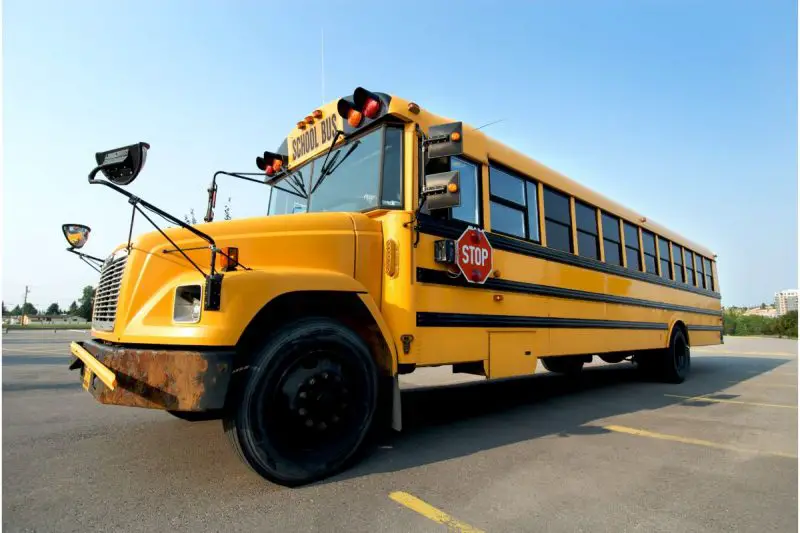One of the most common sights to see around the country is a school bus. A daily occurrence that transports students from the pick-up spot to their school and back home again.
But have you ever thought about how much they might weigh? We’ve wondered it ourselves so we’re going to look into how much an average school bus weighs when it is empty and how heavy it is when it is full.
So, if you’re wondering about it – here are the answers for you with this helpful guide below.
Empty School Buses – What’s The Weight?
School buses are not all the same. You can see a whole array of different sizes and different types of school buses, so when it comes to working out how much they weigh – they’ll likely not be the same weight.
However, despite the variables, we can give an informed estimate of the general weight of one of these buses.
An average and empty school bus weighs about 7.5 tons or about 15,000 pounds. This weight takes into account the weight of the liquids such as fuel, water, etc., and additional modifications that a school bus might have.
Even though school buses are all different, there are standard models and as a result, you can create an estimate that should be somewhere in the ballpark of accuracy.
How Heavy Is A Small School Bus?
School buses are categorized into types. Small school buses are placed into the type A category and they normally hold about 10 passengers and the driver.
These type A buses are subdivided into a further 2 categories; type A1 and type A2. The first type (A1) weighs about 14,500 pounds. They are the type of school buses that are pretty much converted vans that are not designed to carry too many students.
The second type (A2) buses weigh somewhere between 14,500 pounds and 21,500 pounds. This is between 7 and 11 tons. Once again, this weight is estimated to be like this if it is filled with both passengers and fuel.
This second bus type is much larger than type A1 and as a result, it can certainly hold more passengers. Moreover, it has more of a surface area and requires more parts – which incurs further weight.
If we start to question what the weight of a 24-person capacity school bus will weigh, you can pretty much be certain that the figure will be somewhere between 14,000 and 22,000 pounds when it is full.
Type B buses are pretty small on the grand scale of bus sizes, but they are still longer than either type A buses. However, they do have shorter front ends and the engine tends to be located somewhere under the bus driver’s seat.
Because of their capacity and design, you could hazard a guess that these types of school buses should weigh about 10,000 pounds and they could be higher than this depending on the variables.

What About Large Buses?
Large buses like type C are the classic type of school bus that you will likely have seen on a daily basis. They are often seen with long front noses and a hood.
Of course, these buses are designed to specifically hold and transport many more passengers than the previous types. In fact, they can hold about 70-75 passengers!
If these buses are completely empty, we can estimate that they weigh somewhere between 15,500 and 21,500 pounds. However, the problems of estimation arrive when we fill this bus.
Having said this though, we can still give a rough estimate that if the bus is completely full of 75 passengers and filled with gas, it can weigh about 25,000 to 30,000 pounds. This equates to about 12.5 to 15 tons!
Type D buses are not too dissimilar from type C buses, but there is a slight alteration that the front end is flatter and the door is next to the front door.
Type D buses are rather large, being somewhere near 40-50 feet long and once again, the passenger capacity is in the 70s. Due to their size, they are one of the most common buses to see in large city areas.
However, even with their slight differences, the weight when empty and when full is pretty much the same figure as type C.
What About Full School Buses?
As we previously mentioned, the estimation of full school buses is much more complicated because of the number of variables to take into account. It’s pretty much impossible without conducting an experiment.
You’d need to know the exact weight of every single passenger, the weight of the gas that has been filled in the bus, and even take into account weather conditions and tire inflation rates.
However, if we assume that every passenger on the school bus is a child and discount the weight of the driver and potentially chaperones, we can place a figure of 100 pounds per student.
So, all you would need to do is use the weight of the school bus when empty and calculate the capacity multiplied by 100. This will be the figure in pounds.
This is a good ballpark figure because not every student will weigh 100 pounds and therefore the extra weight can account for the driver and potential adults on the bus.
The largest of the school bus types when they are full can weigh anywhere up to a huge figure of 10,000 pounds more than when they’re empty!
The Bottom Line
School buses can be an enigma when it comes to trying to estimate their overall weight. Even when we take into account the variables, we can give these general figures. We hope this guide has helped!
- What Size is Regular Printer Paper? Quick Guide for Paper Dimensions - June 18, 2023
- What Size is My Monitor: A Comprehensive Guide - June 18, 2023
- How Big is Italy Compared to the US? A Concise Comparison - June 16, 2023

